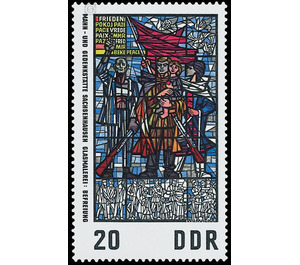National memorial and memorial Sachsenhausen: glass windows - Germany / German Democratic Republic 1968 - 20 Pfennig
Theme: Architecture
| Country | Germany / German Democratic Republic |
| Issue Date | 1968 |
| Face Value | 20.00 |
| Color | multi-colored |
| Perforation | K 14 |
| Printing Type | Photogravure |
| Stamp Type | Postage stamp |
| Item Type | Stamp |
| Chronological Issue Number | 1089 |
| Chronological Chapter | GER-DDR |
| SID | 466416 |
| In 23 Wishlists | |
Stained glass windows of the Sachsenhausen National Remembrance and Memorial Center The Ministry of Posts and Telecommunications of the German Democratic Republic publishes three multicolored commemorative stamps depicting the glass windows of the triptych in the Museum of the Anti-Fascist Liberation Struggle for European Peoples at the Sachsenhausen National Remembrance and Memorial Site. Design and testimony of the glass windows in the Sachsenhausen National Memorial and Memorial The three-part glass window in the "Museum of the Anti-Fascist Liberation Struggle of the European Peoples" in the Sachsenhausen National Memorial and Memorial symbolizes the international resistance struggle against fascism. It was not easy to visualize the representation of the resistance struggle because it took place in the most diverse forms. It was necessary to find a convincing image idea that lived up to the right political and philosophical standpoint of this great event. The theme of the anti - fascist liberation struggle of the European peoples and the German resistance as well as the representation of the victory and the liberation of the fascism by the Soviet army are so complex and full of inner dramatic force in their historical and human content, that it required high concentration and responsibility, in order to Viewers to illustrate everything impressively. For the artistic design three windows were available. In terms of content, these windows, which already demanded the conception of a triptych in their entirety, were structured in such a way that in the left-hand window the illegal resistance struggle, in the right the partisan struggle and in the middle window came to liberation. In order to express the versatility of the struggle, I chose a conception that places at the center of each window larger-than-life, monumentally-shaped groups of figures that symbolize the symbolic exaggeration of the power and invincibility of the anti-fascist national forces. In the background, in a frenzied coloration, frieze-like scenes and realities of the multifaceted struggle and the behavior of the people in this fight are shown. The technique of stained glass was very suitable for the design of this theme. The mosaic-like composition of the colored glasses by means of lead grooves, which give the contour and line, calls for a great simplification of the form. Likewise, the counter light effect of the glass window requires clarity and generous rhythm of the contours. The right-hand window shows in the center a partisan group, a fallen fighter around whom the comrades mourn. But in addition to this mourning, it should be stated that, in spite of the grave sacrifices, the just fight will be continued until victory. The background shows details of this fight, shows farewell and departure of the partisans, fighting scenes and assault on the enemy.


